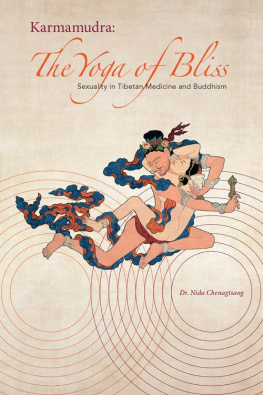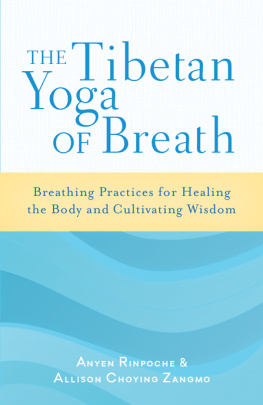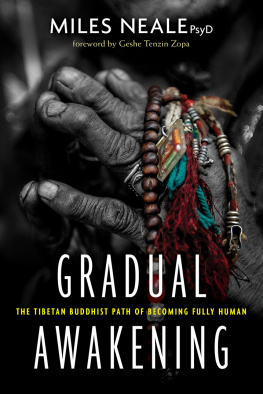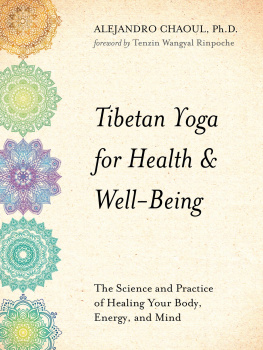Published by: SKY PRESS 3640 SE Washington Street Portland, OR 97214 www.skypressbooks.com Copyright 2018 by Nida Chenagtsang All rights reserved. No part of this book may be reproduced in any form or by any means, electronic or mechanical, including photocopying, recording, or by any information storage and retrieval system, without permission in writing from the publisher. ISBN: 978-1-950153-00-8 Library of Congress Control Number: 2018940097 Editor: Ben Joffe Design and Typesetting: Pearse Gaffney www.mvdigital.nl Yuthok and Vajravarahi illustration by Anna Artemyeva First English Edition Printed on acid-free paper Special thanks to all whose valuable contributions made this work possible.
Chenagtsang, Nida. Karmamudra: The Yoga of Bliss: Sexuality in Tibetan Medicine and Buddhism (Page vii). 978-1-950153-00-8. Kindle Edition.
Dedication xi Karmamudra Prophecy xiii Prefaces 01 Authors Preface 03 Requesting the Blessings of Drukpa Kunley 07 Editor and Translators Foreword 10 Publishers Acknowledgments 34 Introduction Generating Bodhicitta 37 Chapter 1 Clarifying Confusion 41 Karmamudra Today 43 Common Myths and Misconceptions about Karmamudra 47 The Future of Karmamudra 73 Chapter 2 Sutra and Tantra: Renunciation and Transformation 75 Introducing the Buddhist Path 77 Sutra and Tantra: Distinguishing the Two Paths 82 Nyingma and Sarma: The Old and New Schools 108 Worldly versus Wisdom Sex 128 Chapter 3 Tantric Subtle Anatomy 139 The Real You: Yoga and the Vajra Body 141 Tsa, Loong, Thigl 143
Chenagtsang, Nida. Karmamudra: The Yoga of Bliss: Sexuality in Tibetan Medicine and Buddhism (Page viii). 978-1-950153-00-8. Kindle Edition.
I would like to dedicate this book to all victims of sexual abuse and especially to those who have been abused in the name of spiritual and religious traditions. May the pain and suffering caused by sexual abuse swiftly cease in every corner of this earth. - Dr. Nida Chenagtsang
Chenagtsang, Nida. Karmamudra: The Yoga of Bliss: Sexuality in Tibetan Medicine and Buddhism (Page xi). 978-1-950153-00-8. Kindle Edition.
Here in this place, without anybody at all realizing it, Someone is crying out loudly that he loves you, Vajra Dakini, the Guru prophesized that because of your merit and karma, you and I would meet and be together how incredible! This is what is meant by the secret bliss and the magical manifestation of appearances united with emptiness! All-pervasive Lady, be my friend and partner on the Path of Bliss, the path of union through means, And the state of Vajradhara will be in our hands! Prophecy September 24th 2004
Chenagtsang, Nida. Karmamudra: The Yoga of Bliss: Sexuality in Tibetan Medicine and Buddhism (Page xiii). 978-1-950153-00-8. Kindle Edition.
Karmamudra and the Crazy Wisdom Tradition
I would like to greet all the readers of this book from Chim Lhakhang, Drukpa Kunleys temple in the Punakha Valley of Bhutan. This great master, known as the Divine Madman, came here from Tibet after he was completely enlightened, and helped to spread Vajrayana teachings throughout the country of Bhutan and to subdue wrathful demons. We can consider this place to be the birthplace of Crazy Wisdom because Drukpa Kunley is remembered for his wild and outrageous behavior that transcended all social norms and broke through conventional thought patterns and fixations. Drukpa Kunley is especially known as a great master of Karmamudra, probably one of the most famous masters of Karmamudra. When studying Karmamudra, we should understand it from two different perspectives: firstly on a literal, historical level and secondly on a more metaphorical or symbolic level. The first refers to the original classical practice as it has been taught and passed down over the centuries. Drukpa Kunley was truly a wild yogi who achieved realization and taught through his sexuality and other strange and unconventional means such as the hunting of animals and subduing of invisible demons with mantra and wrathful deity practices. This was not metaphor, but a very direct teaching that in 16th Century Bhutan was appropriate and highly effective. I fully understand and respect his method of transmission of the teachings. Drukpa Kunley was a great master with a transcendent level of wisdom, skillful means, attainment, blessings, and power, he was free of negative emotions and therefore transcended the material dimension which is why he was totally free of all social conventions. At the same time, the people had immense and unadulterated faith in him. One story depicted on these temple walls tells of an old man who requested a mantra from Drukpa Kunley and recited it faithfully and ceaselessly for many years. This sacred mantra, however, was in fact merely a string of dirty words that the master gave to this trusting disciple, but due to the blessing power of Drukpa Kunley and the unshakeable faith and diligence of the disciple, this old and uneducated man achieved rainbow body, the highest level of spiritual attainment when ones material body dissolves into light at the time of death. This is the true power of Guru Yoga. The combination of transcendent wisdom on the part of the master, and transcendent devotion on the part of the student is what made these Crazy Wisdom practices so effective during ancient times in a place such as Bhutan. Unfortunately, in todays society, teachers lack the level of realization of the great masters of the past and students lack pure faith, making Crazy Wisdom methods dangerous and confusing. This is why today I think it is important that we understand Drukpa Kunleys stories from a more metaphorical perspective. There are so many crazy modern people that are using the name of Karmamudra, misunderstanding this great teaching, practicing incorrectly and using stories such as those of Drukpa Kunley as an excuse to engage in all sorts of unethical and harmful behavior which is damaging both to practitioners and to the teaching itself. Imitating the behavior of Drukpa Kunley while completely lacking in his wisdom is very dangerous. One of my principal goals in writing this Karmamudra book is to clarify many wrong views about the practice. Of course, traditionally, this is a highly secret practice that is very difficult to receive and some may criticize me for publishing this book. But when we say that it is secret many people think that Vajrayana has something to hide, something that is harmful for the public. This secrecy was originally meant to protect the tradition and to prevent unqualified people from having access to very high level teachings that can be difficult to understand and therefore prone to misinterpretation and misuse. However, it is my opinion that keeping these practices secret and clouded in mystique can be even more harmful, because without proper education and understanding about these practices, wrong views become rampant, especially in the age of internet and social media where all kinds of information spread like wild fire. So my book is really intended to provide clarification and increase transparency about Karmamudra practice which I think is very timely given the recent exposure of so many sexual scandals, both in spiritual and secular communities: in Dharma, politics, Hollywood, and at all levels of society. People have many questions and I have tried to answer these questions by addressing common misconceptions and clearly laying out the difference between true Karmamudra practice and sexual abuse. If we understand the stories of Drukpa Kunley and Crazy Wisdom practices in a more indirect, subtle or metaphorical manner, we can see them as masterful teachings on how to work with our negative emotions and fears and to tame and slaughter the wild and dangerous demons of our own mind. Karmamudra is the most important practice for working with desire. Desire can be a very powerful positive emotion, but at the same time it has a very demonic force that can lead to many disasters and negative results on an individual, family, and societal level. When we lose control of our desire, our desire controls us and we become a slave to our cravings. Buddha taught that desire or attachment is the root cause of all pain and suffering, so in order to be free we must really understand this essential teaching and learn how to harness this extremely powerful force, how to work with this energy and use it as a tool on the path to enlightenment. It is very important for practitioners to understand why we need Karmamudra practice, how important it is, and not just to cast it aside or cover it up because it is controversial or has been misused. It is a teaching that can be incredibly beneficial spiritually, emotionally, psychologically, and physically, if understood in a proper way and not distorted. I would like to thank all of my teachers and especially those who instructed me in Karmamudra: the yogi Lhanyn Rolpatsel (Akhu Lhamo) from the Rebkong ngakpa tradition whose story I tell in this book, and my beloved root teacher, the nun Ani Ngawang Gyaltsen who taught me the Six Yogas, Atiyoga, and Karmamudra in Lhasa, Tibet. I would also like to thank my dearest friend, Tshering Chden whose support and blessings are behind every page of this book. Im very happy to be here today and to receive Drukpa Kunleys blessings for this book in the last days of the Fire Bird year, where the monks are performing a ritual to dispel obstacles in the coming year. I sincerely wish that this book will bring correct information, clarify doubts and confusion, and transmit the positive energy and wisdom of Karmamudra to the general public.
Next page








